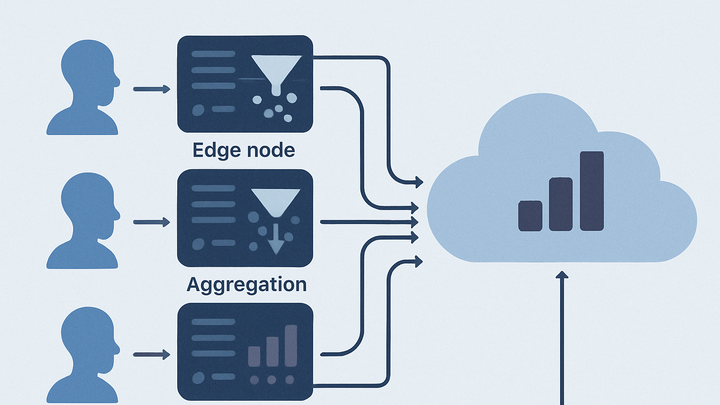Published on 2025-06-22T03:06:54Z
What is Edge Analytics? Examples and Use Cases
Edge Analytics is the practice of processing data close to where it’s generated—on devices, gateways, or near-user servers—instead of sending all raw data back to centralized clouds. By analyzing events at the edge, organizations can reduce latency, save bandwidth, and improve privacy compliance. In web analytics, edge analytics can filter bots, aggregate pageviews, and anonymize IPs before forwarding only the necessary insights to core analytics systems. Leading SaaS tools like PlainSignal and Google Analytics 4 (with server-side tagging) can be configured to perform edge processing, blending the benefits of real-time insights with minimal infrastructure changes. From IoT monitoring to website performance tuning, Edge Analytics unlocks faster decisions and leaner data pipelines.
Edge analytics
Edge Analytics processes data near its source for real-time insights, reduced latency, and improved privacy.
Why Edge Analytics Matters
Edge Analytics shifts computation closer to the data source, delivering critical advantages for modern data-driven operations.
-
Reduced latency
Processing data at the edge cuts down on round-trip times to centralized servers, enabling near-instant insights and faster reactions.
-
Bandwidth efficiency
Local filtering and aggregation ensure only relevant, condensed events traverse the network, lowering data transfer costs.
-
Enhanced privacy and compliance
Sensitive or personally identifiable information can be anonymized or redacted at the edge, aligning with regulations like GDPR before data leaves the user’s environment.
How Edge Analytics Works
A typical edge analytics pipeline involves capturing, transforming, and forwarding data with minimal overhead.
-
Data collection at the source
Lightweight SDKs or scripts embedded in devices or web pages capture raw events as they occur.
-
Local processing and filtering
Edge nodes apply rules to transform, sample, or aggregate incoming data streams before passing them on.
-
Sampling
Select a representative subset of events to reduce volume while preserving statistical validity.
-
Thresholding
Forward only events meeting specific criteria, such as error rates above a defined limit.
-
-
Data forwarding to central systems
Only summarized or filtered insights are transmitted to cloud analytics platforms for storage and deeper analysis.
Implementation Examples
Below are practical code snippets showing how to enable edge analytics with PlainSignal and Google Analytics 4.
-
PlainSignal (cookie-free simple analytics)
PlainSignal runs EU-based edge servers to anonymize and aggregate web events before storage. Drop in this minimal snippet on your pages:
<link rel='preconnect' href='//eu.plainsignal.com/' crossorigin /> <script defer data-do='yourwebsitedomain.com' data-id='0GQV1xmtzQQ' data-api='//eu.plainsignal.com' src='//cdn.plainsignal.com/plainsignal-min.js'></script>It captures pageviews, filters bots, and ensures GDPR compliance without cookies.
-
Google analytics 4 (server-side tagging)
You can deploy a server container on CDN edges (e.g., Cloudflare Workers) to preprocess GA4 events:
<script async src='https://www.googletagmanager.com/gtag/js?id=G-XXXXXXX'></script> <script> window.dataLayer = window.dataLayer || []; function gtag(){ dataLayer.push(arguments); } gtag('js', new Date()); gtag('config', 'G-XXXXXXX', { 'send_page_view': true }); </script>Routing through an edge server lets you filter, enrich, or hash PII before forwarding to Google’s cloud analytics endpoint.
Key Use Cases
Edge Analytics excels in environments where speed, efficiency, and privacy are paramount.
-
Iot device monitoring
Analyze sensor streams locally to detect anomalies and trigger real-time alerts without cloud round-trips.
-
Website performance optimization
Measure and adapt content delivery at CDN edges based on user location, minimizing load times and improving UX.
-
Personalization & a/b testing
Segment user behavior at the edge to instantly deliver tailored experiences and experiment variations.
-
Fraud detection
Score transactions against risk models on edge servers to block suspicious activity in real time.
